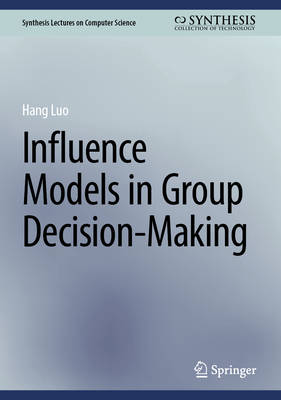
- Afhalen na 1 uur in een winkel met voorraad
- Gratis thuislevering in België vanaf € 30
- Ruim aanbod met 7 miljoen producten
- Afhalen na 1 uur in een winkel met voorraad
- Gratis thuislevering in België vanaf € 30
- Ruim aanbod met 7 miljoen producten
Zoeken
Omschrijving
This book examines influence among decision-makers in group decision-making. It is quite common that people influence and are influenced by each other in group decision-making. Likewise, artificial intelligences can influence and be influenced by each other in interaction or collaboration, and both a person and an artificial intelligence can be called an agent. The author explores how humans or artificial intelligences can interact with and influence each other during the decision-making process, where such influence can reshape the outcome of the group decision. With an interdisciplinary approach, various applications are considered including: computer science (distributed computing, distributed artificial intelligence, particularly multi-agent system); economics and management (joint-stock company voting); and politics (domestic elections and international organization decision-making). The book presents settings of group decision-making where agents' preferences/choices are influenced (and thus changed) by each other. As the influence of reality faced by an agent usually comes from more than one agent simultaneously, the author provides both cardinal and ordinal approaches, building social influence functions and a matrix influence function, to address multiple sources of influence in group decision-making. To better describe the complex influence in reality, the author provides a framework of the three levels of influence and its mathematical models to address individual, coalitional, and structural influence and their mixed effects in the context of group decision-making. Even though it is not easy to address the influence of structures on an agent as the influencing subject and the influenced object are disparate, the former is the inter-relationships between agents while the latter is the preference/choice of a single agent. Furthermore, the author considers combinatorial and collective decision-making and provides a framework model of influence across multiple agents and issues.
Specificaties
Betrokkenen
- Auteur(s):
- Uitgeverij:
Inhoud
- Aantal bladzijden:
- 104
- Taal:
- Engels
- Reeks:
Eigenschappen
- Productcode (EAN):
- 9783032013514
- Verschijningsdatum:
- 14/11/2025
- Uitvoering:
- Hardcover
- Formaat:
- Genaaid
- Afmetingen:
- 168 mm x 240 mm
- Gewicht:
- 322 g

Alleen bij Standaard Boekhandel
+ 137 punten op je klantenkaart van Standaard Boekhandel
Beoordelingen
We publiceren alleen reviews die voldoen aan de voorwaarden voor reviews. Bekijk onze voorwaarden voor reviews.








